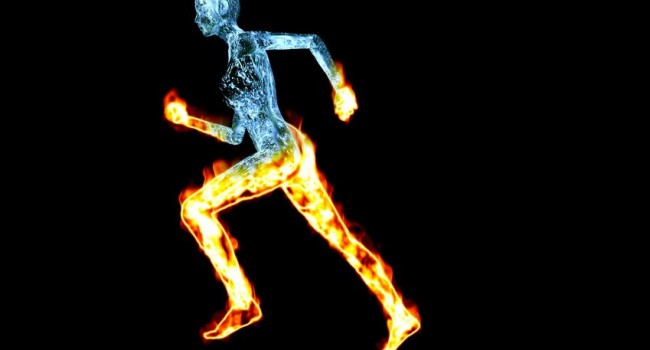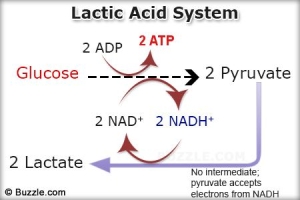Source of Fuel – The lactic acid energy system uses carbohydrates (CHO) as its only source of fuel
and relies on anaerobic glycolysis for its production of ATP. Glycolysis is the breakdown of glucose to produce ATP. In anaerobic glycolysis the glucose (sourced from glycogen in the muscle or glucose in the blood) is turned into lactic acid as it produces ATP.
Efficiency of ATP Production – This system produces ATP at a fast rate and can produce a lot of ATP. The lactic acid system produces 2 ATP for each glucose molecule it breaks down, however, it also produces lactic acid in the process.
Duration that the system can operate – The lactic acid system lasts between 30 seconds and 3 minutes depending on the intensity. The less intense the activity the longer it will last, because it will be producing lactic acid at a slower rate at the lower intensity levels.
Cause of fatigue – The cause of fatigue in the lactic acid system is the build up of pyruvic acid in the muscle. Pyruvic acid is made up of two molecules; pyruvate and a hydrogen ion (H+). Without oxygen the body converts the pyruvate and two H+ to lactate. This helps to reduce the acidity of the muscle and allows anaerobic glycolysis to last longer, as the lactate is removed from the muscle and taken to the liver where it is converted to a useful fuel source such as glucose. However, in continued high intensity activity the lactate cannot be removed fast enough, which results in a build up of pyruvic acid. It is specifically the build up of the H+ within the muscle that causes fatigue. It does this by increasing the acidity of the muscle and causing the enzymes needed for anaerobic glycolysis to slow down.[1]
By-products of energy production – The main by-product of the lactic acid system is pyruvic acid (pyruvate and H+). This by-product is then converted to lactate and transported out of the muscle to the liver to be converted to glucose.
Process and rate of recovery – The process of recovery once fatigue has occurred requires oxygen. Pyruvic acid in the presence of oxygen will be converted to acetyl coenzyme A, which is then broken down through the Krebs cycle to produce more ATP. Without oxygen it is converted to lactate and removed from the muscle and taken to the liver to be converted into glucose. This process can take anywhere between 30 and 60 min.
Examples – The lactic acid energy system is the dominant system in sports, which require a high intensity for longer than 10 seconds. Sports such as 200m or 400m run, or 50m and 100m swim are highly reliant on the lactic acid system. Other times when it is used would include repeated high intensity activities during other sports such as tennis running back and forth with small breaks in-between, repeated tackles in rugby or an extended piece of high intensity in any other sport such as a full-back going forward in an attack and then having to retreat in soccer.
[1] http://www.ptdirect.com/training-design/anatomy-and-physiology/the-aerobic-system


